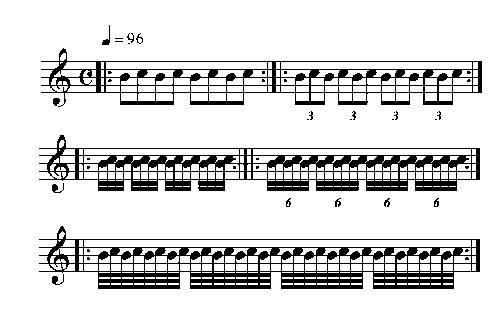The trill is surely one of the most ubiquitous flute and piccolo sounds. A trill is a rapid alternation between two pitches of a half or whole step. (Any interval greater than that is a tremolo.) The proper style and execution of trills is determined by the musical era of the music, such as the Baroque period. Piccolo music includes literature from each of the periods, including solo works by Vivaldi, as well as orchestral and operatic music by Mozart and Beethoven.
Trills can be metered, free, slow down towards the end, speed up, or be played in an even tempo, but what-ever style is used, they must be under control. Each of these technical options create a different musical meaning from a heroic sound to a delicate, shimmering ornament that is light and coquettish.
Both notes of a trill should speak with equal clarity and volume and neither one receives an accent. I have always found it easier to begin a trill, and harder to control the finger action that brings the trill to rest. To end trills on time, count carefully and place the termination squarely on top of the beat. Trills should be practiced carefully and slowly with a metronome, starting in alternating eighth notes, moving to a triplet rhythm, sixteenth notes, groups of six to a beat, and finally eight notes to a beat.

This systematic approach will develop a smooth and rapid finger action. The last etude in Taffanel & Gaubert’s Daily Exercises, #17, is also a very worthy trill study. Keep the fingers light and free when moving quickly from note to note and remember that the movement occurs from the knuckle down through the fingertip.
Certain piccolo trills are a bit trickier to master than on the flute, partly because of their response, and at other times because of the fingering. I have assembled a list of the top 10 tricky trills, and offer a fingering solution for each one. They seem to show up in music with great regularity, so memorizing these trill fingerings is essential. If you cannot memorize a fingering, then write it in above the trill.
(Red indicates the key that trills.)
1. The first trill key provides a degree of stability, rather than moving the left-hand first finger and thumb combination. Th 1 4/ Tr#1 4
.jpg)
2. Although this fingering is slightly sharp, it provides a beautiful tone and stability while holding the piccolo. Th 24/ 1 2 4
.jpg)
3. Both trill keys provide a more open tone quality. Th 23/ Tr#1 #2 4
.jpg)
4. This fingering is quite different from the traditional flute fingering, but it provides better intonation on piccolo. Th 1234 / 1234
.jpg)
5. This is a common trill in band music so it is a good one to memorize! Th 23 / 1234
.jpg)
6. I’ve provided a traditional fingering and one that works well with a split-E key. Th 12 / 12 4 with split-E key: Th 12 4/ 12 4
.jpg)
7. The Nutcracker is famous for this trill. This fingering is less resistant than the traditional thumb-only trill used on flute. Th 13 / 1 4
.jpg)
8. This is one of our most awkward trills, but the split-E key really makes the second fingering a breeze. Th 23 / 234 with split-E key: 1234/ Tr#1 4
.jpg)
9. This is another trill found often in band literature. 234/ Tr#1 4
.jpg)
10. Also found frequently in band literature, this trill’s intonation improves with this fingering. Th 2/ 1 Tr#1 #2 4
.jpg)
I hope this list of the most often encountered trills makes your musical life more comfortable. Memorize them whenever possible and try to produce the most musical presentation of these quick little ornaments you can.






